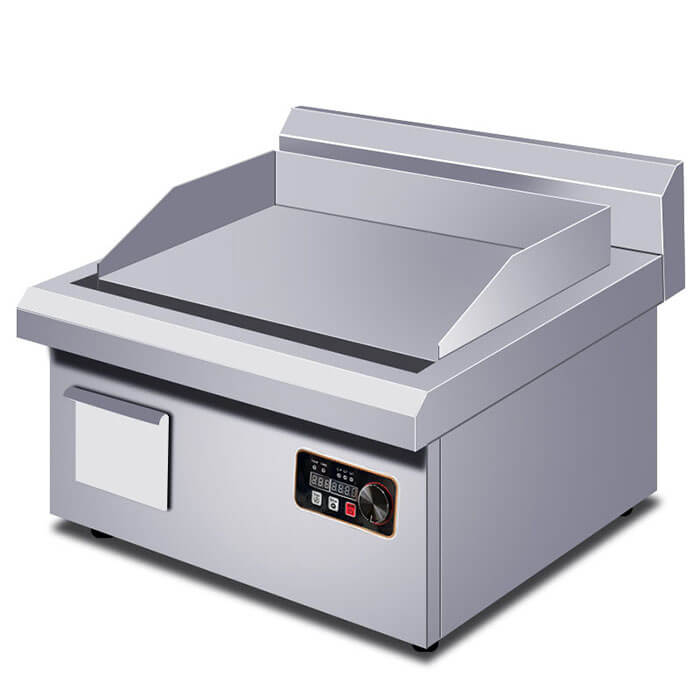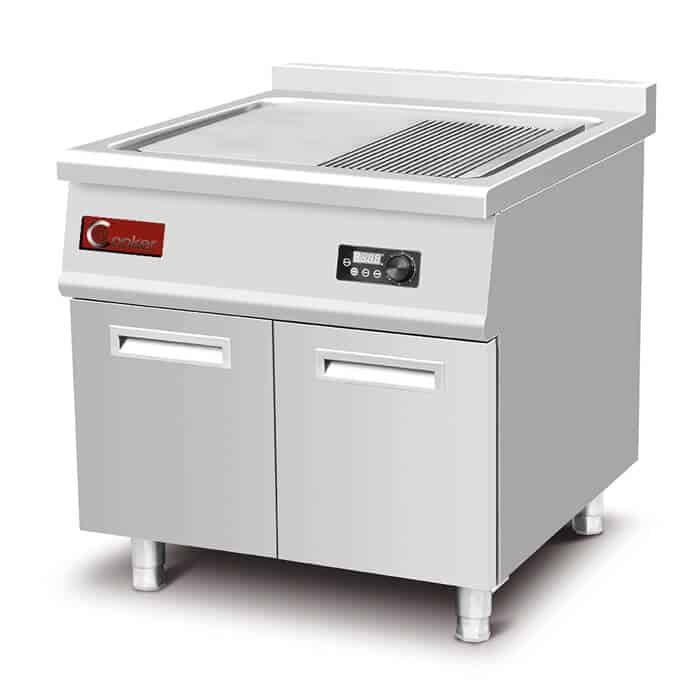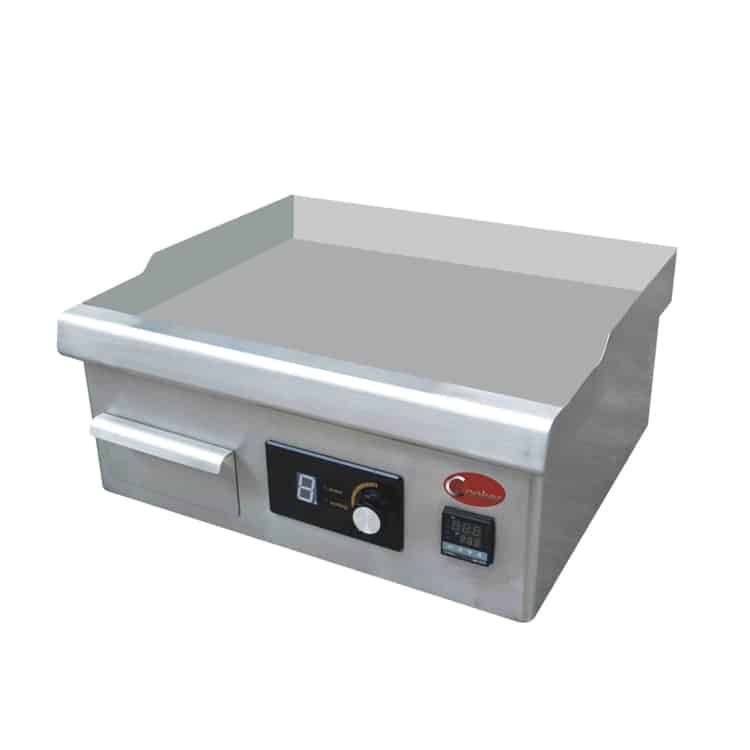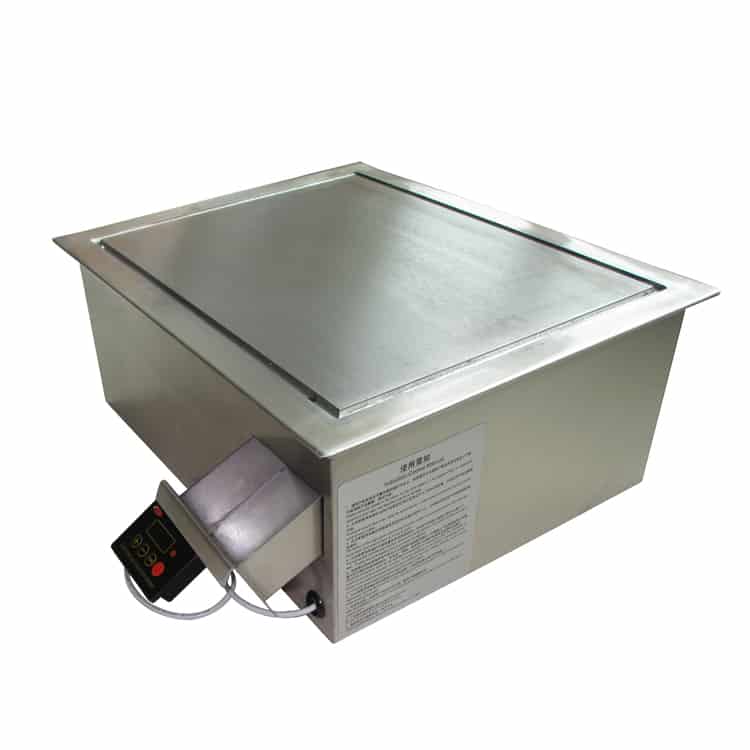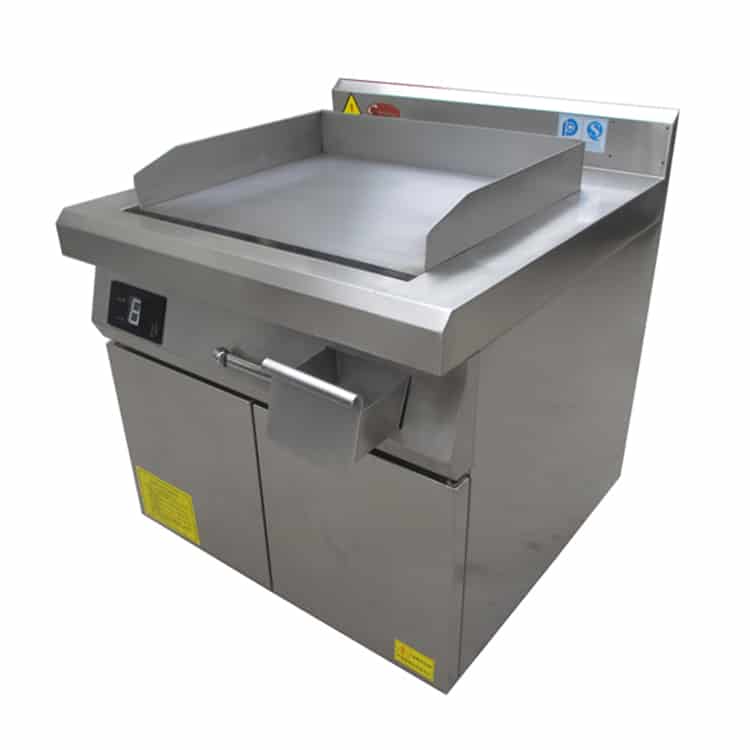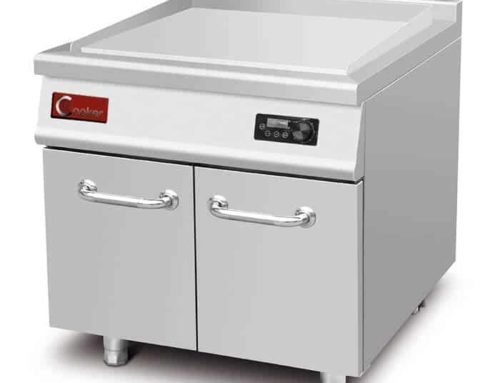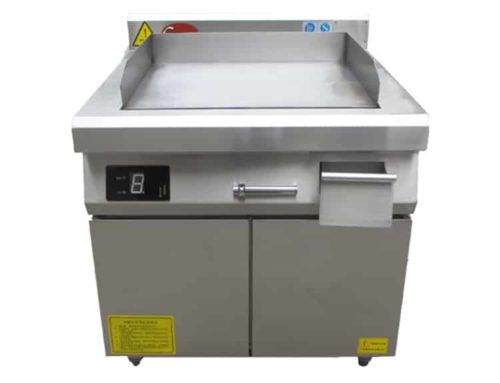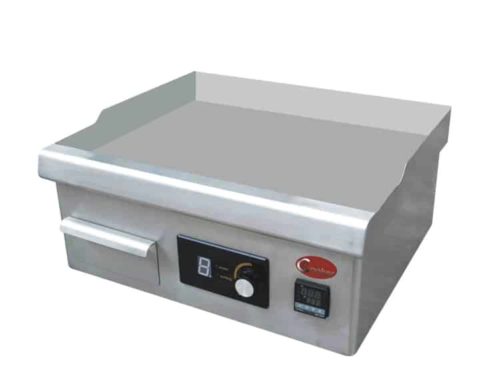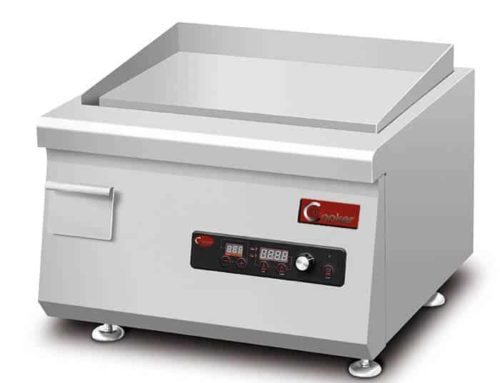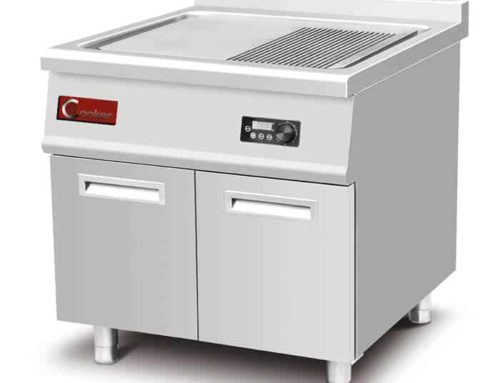What Are the Key Differences Between Steel and Chrome Cooking Surfaces for Flat Grills?
For flat grills—whether used in restaurants (as restaurant grill setups), commercial kitchens (as commercial flat top grill units), or catering events—the choice between steel and chrome cooking surfaces directly impacts performance, maintenance, and longevity. Steel (often carbon steel or stainless steel flat top grill variants) and chrome-plated surfaces each have unique strengths: steel excels at heat retention and durability, while chrome offers easy cleaning and non-stick properties.
AT Cooker’s QRPLT-A5CB35 commercial flat top grill—a 3500W countertop induction model—highlights steel’s advantages through its 304 stainless steel body (per the document), though its cooking surface uses 6mm tempered glass (a third option, but steel remains critical for structural durability). To help you choose between steel and chrome for your flat grill top, we break down 13 key differences, linking each to real-world use cases (e.g., searing burgers on steel vs. cooking delicate eggs on chrome) and maintenance needs. Whether you prioritize high-heat performance, easy cleanup, or long-term value, this guide clarifies which surface aligns with your commercial grill goals.
1. Steel Cooking Surfaces Offer Excellent Heat Retention and Even Distribution
Steel—especially carbon steel or thick-gauge stainless steel—is renowned for its superior heat retention and even distribution, making it the top choice for flat grills used in high-heat cooking (e.g., searing steaks, grilling burgers). Unlike chrome, which acts as a thin conductive layer, steel’s density allows it to absorb and hold heat, ensuring consistent temperatures across the entire flat grill top.
### How Steel Delivers Heat Performance
– **Thickness Matters**: Commercial steel flat grills typically use 10–15mm-thick plates (e.g., Vulcan’s carbon steel flat tops). This thickness prevents hot spots—critical for cooking batches of food uniformly. For example, a steel surface maintains 375°F ±5°F across its entire area, while a chrome surface may vary by ±20°F.
– **Heat Recovery Speed**: After placing cold food on the grill, steel rebounds to the set temperature in 30–60 seconds, vs. 1–2 minutes for chrome. This is essential for busy restaurant grill stations where food is cooked continuously.
– **Induction Compatibility**: Steel works seamlessly with induction technology (like AT Cooker’s QRPLT-A5CB35). The QRPLT-A5CB35 uses a steel-reinforced induction coil system to transfer heat directly to ferrous cookware, leveraging steel’s magnetic properties for efficient heating.
### Real-World Use Case
A burger joint in Chicago uses a stainless steel commercial flat top grill for its signature patties: “We cook 500+ burgers daily. The steel surface holds heat so well that every patty gets a perfect sear, even when we’re grilling 20 at a time. With our old chrome grill, we had to wait for the surface to reheat between batches—costing us 15 minutes of service time.”
2. Chrome Surfaces Provide a Smooth, Non-Stick Finish That Aids in Food Release
Chrome-plated cooking surfaces are valued for their ultra-smooth, naturally non-stick finish—an advantage for flat grills used to cook delicate or sticky foods (e.g., eggs, pancakes, grilled cheese). The chrome plating creates a slick barrier that prevents food from adhering, reducing the need for excess oil and simplifying initial cleanup.
### How Chrome Enhances Food Release
– **Micro-Smooth Surface**: Chrome plating is polished to a mirror finish, eliminating tiny pores where food particles can stick. This is ideal for commercial grill setups where quick food turnover is key—e.g., a breakfast diner cooking 300+ eggs daily.
– **Minimal Oil Needed**: Unlike steel (which requires seasoning to build a non-stick patina), chrome surfaces need only a light spray of oil to prevent sticking. This makes them a good choice for health-conscious kitchens or menus focused on low-fat cooking.
– **Gentle on Delicate Foods**: Chrome’s non-stick property ensures fragile items like fish fillets or thin crepes don’t tear when flipped—a common issue with unseasoned steel surfaces.
### Real-World Use Case
A café in Seattle uses a chrome flat grill top for its weekend brunch service: “Our signature dish is lemon ricotta pancakes. The chrome surface lets us flip them without sticking, even when we’re making 100 at a time. Cleanup is fast too—we just wipe the surface with a damp cloth between batches.”
### Limitation to Note
Chrome’s non-stick advantage fades over time: after 6–12 months of heavy use, the plating wears thin, and food starts to stick. This requires either re-plating (costing $200–$400 per grill) or replacing the surface—an expense steel surfaces avoid.
3. Steel Surfaces Are More Durable and Resistant to Warping Under High Heat
Steel is far more durable than chrome when exposed to the high temperatures (400–600°F) common in commercial flat top grill use. Its inherent strength resists warping, scratching, and impact damage—critical for busy kitchens where grills are used 8+ hours daily.
### Steel’s Durability Advantages
– **Warp Resistance**: Thick-gauge steel (10mm+) maintains its shape even when subjected to rapid temperature changes (e.g., placing a cold pan on a hot surface). Chrome-plated surfaces, by contrast, use thin steel cores (4–6mm) with a chrome layer, making them prone to warping after 1–2 years of heavy use.
– **Scratch Tolerance**: Steel withstands metal utensils (spatulas, tongs) without damage. Chrome plating, however, scratches easily—even minor scrapes expose the underlying steel, leading to rust and further plating loss.
– **Impact Resistance**: Steel surfaces can handle accidental drops of cookware (e.g., a cast iron skillet) without cracking. Chrome plating chips or peels on impact, rendering the surface unusable until repaired.
### Durability Comparison
| Surface Type | Typical Thickness | Warp Resistance | Scratch Tolerance | Impact Resistance |
|————–|——————-|—————–|——————-|——————-|
| Steel (Carbon/Stainless) | 10–15mm | Excellent (5–7 years) | High | Excellent |
| Chrome-Plated Steel | 4–6mm core + 0.1mm chrome | Poor (1–2 years) | Low | Poor |
### Real-World Example
A catering company uses a steel commercial grill for outdoor events: “We transport the grill to 15+ events monthly. It’s been dropped, rained on, and used non-stop—after 3 years, there’s no warping or scratches. Our old chrome grill lasted 8 months before the plating chipped and it warped.”
4. Chrome Plating Can Wear Off Over Time, Requiring Re-Plating or Replacement
Chrome plating is a thin layer (0.05–0.1mm) applied to a steel core, and it’s not designed for long-term durability in high-volume flat grills. With regular use, the plating wears away—exposing the underlying steel to moisture, food, and cleaning chemicals—and eventually requires costly repairs or full surface replacement.
### Why Chrome Wears Out
– **Abrasive Wear**: Daily cleaning with scrapers or brushes (even non-abrasive ones) gradually removes the chrome layer. In restaurant grill settings, where grills are cleaned 3–4 times daily, plating can wear thin in as little as 6 months.
– **Heat Degradation**: High temperatures (above 400°F) break down the chrome-steel bond, causing the plating to peel or bubble. This is common in grills used for searing, where temperatures often exceed 450°F.
– **Chemical Damage**: Harsh cleaning chemicals (e.g., oven cleaners, acidic degreasers) corrode chrome, accelerating wear. Even mild dish soap, if left on the surface, can dull the plating over time.
### Cost of Chrome Maintenance
– **Re-Plating**: Professional chrome re-plating for a standard 36” flat grill top costs $200–$400 and takes 3–5 days (meaning downtime for your kitchen).
– **Replacement**: A new chrome-plated surface costs $500–$800, vs. $800–$1,200 for a steel surface—but the steel surface lasts 3–4x longer.
### Real-World Cost Example
A diner in Miami tracked maintenance costs for its chrome grill: “We re-plated the surface twice in 2 years, costing $700 total. After that, we switched to a stainless steel grill—no maintenance costs in the 3 years since. The steel grill paid for itself in saved repairs.”
5. Steel Surfaces Develop a Natural Seasoning That Enhances Flavor and Prevents Sticking
One of steel’s most unique advantages is its ability to develop a natural “seasoning”—a polymerized layer of oil that builds up with use. This seasoning improves over time, creating a non-stick surface that enhances food flavor and reduces maintenance needs—making steel ideal for long-term use in commercial flat top grill setups.
### How Seasoning Works
– **Build Process**: Each time you cook on steel, a thin layer of oil is heated to its smoke point, bonding to the surface. Over weeks of use, this layer thickens, creating a smooth, non-stick barrier that rivals chrome’s initial performance.
– **Flavor Enhancement**: The seasoning traps subtle flavor compounds from previous cooks (e.g., garlic, herbs), adding depth to future dishes. This is a prized feature in restaurant grill menus—e.g., a steakhouse where the grill’s seasoning contributes to its signature taste.
– **Self-Healing Property**: Minor scratches in the seasoning can be repaired by re-oiling and heating the surface, unlike chrome (which requires professional repair if chipped).
### How to Season a Steel Flat Grill
1. Clean the surface with warm water and a mild cleaner to remove factory residue.
2. Dry the surface completely, then apply a thin layer of high-smoke-point oil (e.g., flaxseed, canola).
3. Heat the grill to 400°F and let the oil smoke for 30 minutes.
4. Cool the surface, then wipe away excess oil. Repeat 3–4 times before first use.
5. After each use, wipe the surface with a damp cloth and reapply a light layer of oil to maintain the seasoning.
### Real-World Example
A BBQ joint in Austin has used the same steel commercial grill for 10 years: “Our regulars say our ribs taste better than anywhere else—and it’s the grill’s seasoning. We’ve never had to replace the surface; we just keep seasoning it. It’s non-stick now, and every cook adds more flavor.”
| Feature | Steel Cooking Surfaces | Chrome Cooking Surfaces | Best For |
|---|---|---|---|
| Heat Retention | Excellent (10–15mm thickness holds heat for 15+ minutes) | Poor (thin plating + core loses heat quickly) | Steel: High-heat searing (burgers, steaks) |
| Non-Stick Performance | Good (improves with seasoning over weeks/months) | Excellent (out of the box, declines over time) | Chrome: Delicate foods (eggs, pancakes) |
| Durability | 7–10 years (resists warping, scratches) | 2–3 years (plating wears, core warps) | Steel: High-volume commercial use |
| Maintenance | Requires seasoning and regular oiling | Requires soft cleaning tools and pH-neutral cleaners | Chrome: Low-maintenance short-term use |
| Flavor Impact | Enhances flavor (seasoning adds depth) | Neutral (no flavor contribution) | Steel: Restaurants prioritizing signature flavor |
| Cost Over 5 Years | $800–$1,200 (one-time purchase, no repairs) | $1,200–$1,800 (initial purchase + re-plating/replacement) | Steel: Long-term cost savings |
6. Chrome Surfaces Are Easier to Clean Initially Due to Their Slick Texture
Chrome-plated flat grills have a clear advantage when it comes to initial cleaning: their slick, non-porous surface prevents food from sticking, allowing staff to wipe away spills and residue in seconds—critical for commercial grill setups with tight service windows (e.g., fast-casual restaurants, food trucks).
### Why Chrome Cleans Faster
– **No Food Bonding**: Chrome’s smooth surface means burnt-on food doesn’t adhere—unlike unseasoned steel, where food can bake into pores. A quick wipe with a damp cloth or grill scraper is often enough to clean chrome after use.
– **Minimal Scrubbing**: Staff don’t need to use abrasive tools or soak the surface to remove residue. This reduces cleaning time by 50% compared to steel (which may require scrubbing to remove stuck-on food before seasoning).
– **Consistent Cleanliness**: Chrome’s mirror finish makes it easy to spot remaining food particles, ensuring the grill meets hygiene standards—important for commercial kitchens subject to health inspections.
### Real-World Use Case
A food truck operator uses a chrome flat grill top for its lunch rush: “We serve 200+ customers in 3 hours. The chrome surface cleans so fast that we can wipe it down between orders—no downtime. With our old steel grill, we had to stop service for 10 minutes to deep-clean stuck-on food.”
### Limitation to Note
Chrome’s easy cleaning fades as the plating wears. After 6–12 months, food starts to stick, and cleaning takes as long (or longer) than steel. Steel, by contrast, becomes easier to clean as its seasoning builds—requiring only a quick wipe in later years.
Cleaning Time
Chrome (Initial Use)
Steel: 2–3 Min (Unseasoned)
Surface Lifespan
Steel (With Seasoning)
Chrome: 2–3 Yrs
5-Yr Maintenance Cost
Steel (No Repairs)
Chrome: $700+ (Re-Plating)
7. Steel Grills May Require More Maintenance to Prevent Rust and Corrosion
While steel is durable, it is prone to rust and corrosion if not properly maintained—especially carbon steel (the most common type for flat grills). This requires regular maintenance to protect the surface, making steel a better choice for kitchens willing to invest time in upkeep.
### Why Steel Rusts
– **Iron Content**: Steel contains iron, which reacts with moisture and oxygen to form rust. This is a risk in commercial kitchens, where grills are exposed to spills, steam, and frequent cleaning.
– **Porous Surface**: Unseasoned steel has tiny pores that trap moisture, accelerating rust formation. Even seasoned steel can rust if the seasoning is damaged and not repaired quickly.
– **Chemical Exposure**: Acidic foods (e.g., tomatoes, vinegar) or harsh cleaners can break down the seasoning, exposing the steel to rust-causing elements.
### Maintenance to Prevent Rust
1. **Daily Oiling**: After cleaning, apply a thin layer of oil to the steel surface to seal out moisture.
2. **Dry Thoroughly**: Always dry the surface completely after cleaning—never leave standing water on steel.
3. **Repair Seasoning**: If the seasoning is scratched or worn, re-season the affected area immediately to prevent rust.
4. **Use Stainless Steel for Humid Environments**: For coastal or high-humidity locations, choose a stainless steel flat top grill (like AT Cooker’s 304 SS body). Stainless steel contains chromium, which forms a protective oxide layer that resists rust.
### Real-World Example
A seafood restaurant in Florida uses a stainless steel commercial flat top grill to combat humidity: “The ocean air is brutal on metal. Our stainless steel grill has no rust after 4 years, but our old carbon steel grill rusted within 6 months. We just wipe it down and oil it daily—minimal work for the durability we get.”
8. Chrome Surfaces Resist Rust Better but Can Chip or Crack Under Heavy Use
Chrome plating acts as a barrier between the underlying steel core and moisture, giving chrome flat grills better initial rust resistance than unseasoned steel. However, this advantage is lost if the plating chips or cracks—exposing the core to rust-causing elements.
### How Chrome Resists Rust
– **Protective Barrier**: Chrome is non-porous and does not react with moisture, preventing rust from forming on the surface. This makes chrome a good choice for commercial grill setups where frequent cleaning with water is necessary (e.g., a deli that cleans the grill after every shift).
– **No Seasoning Needed**: Unlike steel, chrome does not require oiling to prevent rust—just regular cleaning. This simplifies maintenance for kitchens with limited staff time.
### Why Chrome Fails to Resist Rust Long-Term
– **Plating Damage**: Even minor impacts (e.g., dropping a spatula) can chip the chrome plating. Once the core steel is exposed, rust forms quickly—often spreading under the remaining plating and causing further peeling.
– **Edge Wear**: The edges of chrome flat grill top surfaces wear fastest, as they’re more likely to come into contact with utensils or cookware. Rust along the edges is a common issue after 1 year of use.
### Real-World Example
A sandwich shop in Boston had a chrome grill that rusted after 18 months: “A cook dropped a metal pan on the edge, chipping the chrome. Within a month, there was rust along the entire edge. We tried to clean it, but the rust kept spreading. We had to replace the surface for $600.”
— Mike, Diner Owner (Chicago, IL)
9. Steel Surfaces Are Preferred for High-Heat Searing and Heavy-Duty Cooking
Steel’s ability to withstand extreme temperatures (up to 800°F, per AT Cooker’s document for high-temperature tolerance) makes it the preferred choice for flat grills used in high-heat cooking—e.g., searing steaks, charring vegetables, or cooking thick cuts of meat. Chrome, by contrast, cannot handle high heat without damage, limiting its use to low-to-medium heat applications.
### Why Steel Excels at High Heat
– **Heat Tolerance**: Steel’s high melting point (1,450°F for carbon steel) allows it to reach and maintain searing temperatures (450–600°F) without warping or damage. Chrome plating melts at 2,500°F, but the thin layer and underlying steel core warp at 400°F+, making high-heat use risky.
– **Maillard Reaction Support**: The Maillard reaction (which creates rich, browned flavors in seared food) requires consistent high heat. Steel’s heat retention ensures every part of the food comes into contact with a hot surface, achieving perfect searing.
– **Heavy-Duty Construction**: Steel commercial grill surfaces are built with thick frames and supports, allowing them to handle heavy cookware (e.g., cast iron Dutch ovens) or large batches of food—common in high-volume kitchens.
### Real-World Use Case
A steakhouse in Dallas uses a carbon steel flat grill top for its dry-aged steaks: “We sear steaks at 550°F to get that perfect crust. Our steel grill holds that temperature all night, even when we’re cooking 30 steaks at a time. With a chrome grill, we’d never get the same sear—plus, the plating would warp after the first use.”
10. Chrome Surfaces Offer a Shinier Appearance, Appealing for Presentation
Chrome-plated flat grills are valued for their sleek, mirror-like appearance—an advantage for kitchens where presentation matters (e.g., open kitchens, food trucks, or catering events). The shiny surface adds a professional, clean look that can enhance the customer experience, even if it doesn’t improve cooking performance.
### Why Chrome Shines for Presentation
– **Visual Appeal**: Chrome’s reflective surface looks modern and well-maintained, which is important for open kitchens where customers can see the grill. A shiny chrome grill signals cleanliness, which builds customer trust.
– **Photography-Friendly**: Chrome surfaces look great in food photos or social media content—critical for restaurants that market themselves online. The reflective finish can make food (e.g., golden pancakes, perfectly grilled veggies) appear more appetizing.
– **Brand Image**: For upscale cafes or boutique catering companies, chrome’s polished look aligns with a premium brand aesthetic, while steel’s more industrial appearance may feel too casual.
### Real-World Use Case
A trendy brunch spot in Los Angeles uses a chrome commercial grill in its open kitchen: “Our customers love watching us cook. The chrome grill looks amazing in photos and videos—we get so many compliments on it. It’s not as durable as steel, but for our brand, the presentation value is worth the extra maintenance.”
### Limitation to Note
Chrome’s shine fades over time: plating wears thin, becoming dull and spotted. This can hurt presentation—e.g., a once-shiny grill that now looks worn and unprofessional. Steel, while not as shiny, develops a rich, seasoned patina that many customers associate with “authentic” cooking.
11. Steel Flat Grills Improve with Age Through Seasoning; Chrome Does Not
One of the most significant differences between steel and chrome is how they perform over time: steel flat grills improve with age, while chrome’s performance declines. Steel’s seasoning builds up, creating a better non-stick surface and enhancing flavor, while chrome’s plating wears away, leading to sticking and rust.
### How Steel Improves with Age
– **Seasoning Depth**: After 6–12 months of use, steel’s seasoning becomes thick and durable, requiring less oil and cleaning. A well-seasoned steel grill is as non-stick as a new chrome grill but lasts 3–4x longer.
– **Heat Performance**: The seasoning acts as an insulator, improving heat retention and even distribution. A 5-year-old steel grill may perform better than a new one, as the seasoning has had time to develop fully.
– **Flavor Complexity**: Each cook adds to the seasoning’s flavor profile, making dishes taste more consistent and flavorful. This is a key reason many long-standing restaurants refuse to replace their steel grills.
### How Chrome Declines with Age
– **Plating Wear**: After 6–18 months, chrome’s non-stick plating wears thin, and food starts to stick. By year 2, the surface often requires re-plating or replacement.
– **Rust and Dullness**: Chipped plating leads to rust, and the surface loses its shine, making the grill look unkempt.
– **Heat Inefficiency**: Warped chrome surfaces lose heat unevenly, leading to inconsistent cooking and longer cook times.
### Real-World Comparison
A family-owned diner has used the same steel flat grill top for 15 years: “This grill cooks better now than it did when it was new. The seasoning is perfect—eggs slide right off, and burgers have the best flavor. Our customers say they can taste the difference. We had a chrome grill before this one—it was useless after 2 years.”
12. Chrome Surfaces May Be Less Tolerant of Abrasive Cleaning Tools
Chrome plating is extremely sensitive to abrasive cleaning tools—even minor scratches can damage the surface, exposing the underlying steel and leading to rust. This limits the types of tools you can use to clean chrome flat grills, making them a poor choice for kitchens that deal with heavy, burnt-on food.
### Why Chrome Is Sensitive to Abrasives
– **Thin Plating**: Chrome plating is only 0.05–0.1mm thick—too thin to withstand metal scrapers, steel wool, or abrasive sponges. A single use of a metal scraper can scratch the plating, creating a entry point for rust.
– **Polished Finish**: Chrome’s mirror finish is achieved through extensive polishing, which is easily dulled by abrasives. Even non-abrasive cleaners with small particles (e.g., baking soda) can scratch the surface over time.
### Safe Cleaning Tools for Chrome
– Soft plastic scrapers
– Microfiber cloths
– Sponges with non-abrasive scrub pads
– pH-neutral liquid cleaners (no powders or pastes)
### Real-World Example
A fast-food restaurant accidentally damaged its chrome grill with a metal scraper: “A new cook used a metal scraper to remove burnt-on cheese. Within a week, the scratched area rusted, and the plating started to peel. We had to close for a day to replace the surface, costing us $1,200 in lost revenue.”
### Steel’s Advantage with Abrasives
Steel surfaces can withstand metal scrapers, steel wool, and abrasive cleaners—critical for commercial flat top grill setups where burnt-on food is common. Even if steel is scratched, the damage can be repaired by re-seasoning the surface, unlike chrome (which requires professional repair).
13. Choosing Between Steel and Chrome Depends on Cooking Style and Maintenance Preferences
There is no “one-size-fits-all” choice between steel and chrome—your decision should depend on your flat grill use case, cooking style, and willingness to perform maintenance. Below is a framework to help you choose, with ties to common commercial grill scenarios.
### Choose Steel If:
– **You Cook at High Heat**: Steel is the only option for searing, charring, or cooking thick cuts of meat (400°F+).
– **You Want Long-Term Durability**: Steel lasts 7–10 years with minimal maintenance, making it ideal for high-volume restaurant grill setups.
– **You Don’t Mind Seasoning**: Steel requires initial seasoning and regular oiling, but this work pays off in better performance over time.
– **You Prioritize Low Long-Term Costs**: Steel has no repair or replacement costs, unlike chrome (which needs re-plating every 2–3 years).
### Choose Chrome If:
– **You Cook Delicate, Low-Heat Foods**: Chrome is great for eggs, pancakes, or grilled cheese (200–350°F).
– **You Need Fast Initial Cleaning**: Chrome’s non-stick surface simplifies cleanup for kitchens with tight service windows (e.g., food trucks, breakfast diners).
– **Presentation Matters More Than Longevity**: Chrome’s shiny appearance is ideal for open kitchens or brands focused on aesthetics.
– **You Plan to Replace the Grill Every 2–3 Years**: Chrome is a budget-friendly short-term option, but it’s not cost-effective long-term.
### AT Cooker’s Recommendation for Hybrid Needs
If you want the best of both worlds, consider AT Cooker’s QRPLT-A5CB35. While its cooking surface is 6mm tempered glass (non-stick, easy to clean like chrome), its 304 stainless steel body (document-specified) provides steel-like durability. The induction system lets you use steel cookware for high-heat searing, while the glass surface offers chrome-like easy cleaning—perfect for kitchens with diverse menus.
Choose the Right Surface for Your Flat Grill with AT Cooker
Whether you need a stainless steel flat top grill for high-heat searing or a chrome surface for delicate cooking, AT Cooker’s QRPLT-A5CB35 offers a versatile solution. Its 304 stainless steel body delivers steel’s durability, while its induction system and tempered glass surface provide chrome-like easy cleaning. Share your menu (e.g., burgers, eggs, steaks) and daily cooking volume—our experts will help you determine if steel, chrome, or AT Cooker’s hybrid design is best for your commercial flat top grill needs.
